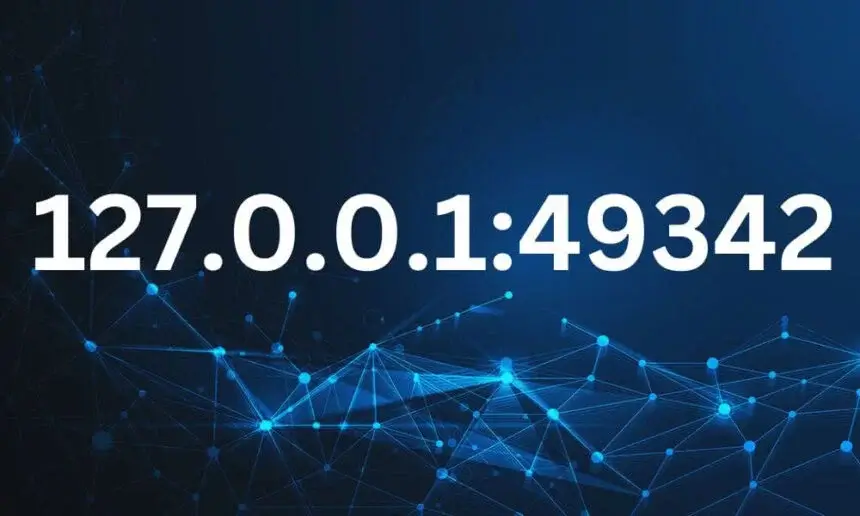Introduction
Imagine you’re setting up a small, virtual town where all the buildings are your applications, and the roads connecting them are the network. Now, what if you had a special address that always pointed back to this town, no matter where you were? That’s what 127.0.0.1 represents in the world of networking—it’s like the ultimate home address for your computer. And what about 49342? Well, that’s just the specific street you’re driving on, or in technical terms, the port where your application is running.
In this article, we’ll take a deep dive into what 127.0.0.1:49342 means, how it works, and why it’s essential for developers, network engineers, and anyone dabbling in the vast world of computer networking.
What is 127.0.0.1?
Let’s start with the basics. 127.0.0.1 is known as the localhost or loopback address in networking. Think of it as the “home base” for your computer. Whenever you type 127.0.0.1 into your browser’s address bar or use it in a network-related command, you’re essentially telling your computer to connect to itself.
The Role of 127.0.0.1 in Networking
In networking terms, 127.0.0.1 is an IP address that directs the traffic back to your machine. This is incredibly useful for testing and development purposes because it allows developers to run applications on their computers without exposing them to the internet.
The Concept of Loopback Address
So, what exactly is a loopback address? The loopback address is a special IP address, and 127.0.0.1 is the most commonly used one. It’s like a feedback loop for your network; any data sent to this address is immediately routed back to the same device.
How 127.0.0.1 Functions as a Loopback
When your computer sends data to 127.0.0.1, it doesn’t go out onto the actual network. Instead, it stays within the device, making it ideal for testing network configurations and applications without affecting or exposing them to the outside world.
Understanding Port Numbers
Now that we’ve covered 127.0.0.1, let’s talk about port numbers. In networking, a port number is a way to identify a specific process or service running on your computer. Imagine it as a door number in an apartment building—the building is your computer, and the doors are different services.
The Role of Ports in Communication
Ports allow different applications to use the network simultaneously without interfering with each other. For instance, your web browser might use port 80 or 443 to connect to the internet, while your email client might use a different port to receive messages.
What Does 49342 Represent?
The number 49342 is a port number. In this context, it’s a non-standard port, meaning it’s not one of the well-known ports like 80 (HTTP) or 443 (HTTPS). Non-standard ports are often used for custom applications or services, adding an extra layer of flexibility and, sometimes, security.
The Significance of Non-Standard Ports
Using a non-standard port like 49342 can help in scenarios where you want to run multiple services on the same machine without them clashing. It’s also a common practice to use non-standard ports to avoid certain types of network attacks that target well-known ports.
How 127.0.0.1:49342 Works Together
When you combine 127.0.0.1 and 49342, you get 127.0.0.1:49342—a specific address and port on your computer. This combination is often used in local development environments, where an application might be hosted on 127.0.0.1 and listen for requests on port 49342.
Practical Examples of 127.0.0.1:49342 Usage

For example, a web developer might run a local server on 127.0.0.1:49342 to test a new website. Instead of exposing the site to the internet, they can access it by typing 127.0.0.1:49342 into their browser, ensuring everything works as expected before going live.
Common Use Cases
Local Development and Testing
One of the most common uses of 127.0.0.1:49342 is in software development. Developers use it to run and test applications locally before deploying them to production. This way, they can debug and refine their code in a controlled environment.
Network Diagnostics and Troubleshooting
Network administrators often use 127.0.0.1:49342 for troubleshooting purposes. By running diagnostic tools on this address and port, they can identify issues in the network stack without external interference.
Security Implications
While 127.0.0.1 is inherently secure because it’s local to your machine, using specific ports like 49342 can have security implications. It’s essential to ensure that any service running on this port is correctly configured to prevent unauthorized access.
The Importance of Localhost in Development
Why Developers Use Localhost
Developers love localhost because it provides a safe, isolated environment for testing. By using 127.0.0.1, they can simulate real-world scenarios without the risks associated with exposing their applications to the internet.
Benefits of Testing on 127.0.0.1
Testing on 127.0.0.1 offers numerous advantages, such as faster feedback loops, easier debugging, and the ability to experiment without fear of affecting live users or data.
Security Aspects of Using 127.0.0.1:49342
Potential Risks of Using Specific Ports
While 127.0.0.1 is generally secure, running services on specific ports like 49342 can introduce risks. If not properly secured, these services could be exploited by malicious software or unauthorized users.
Best Practices for Securing Localhost
To secure your localhost setup, always ensure that only trusted applications are allowed to run on specific ports. Use firewalls and configure access controls to prevent unauthorized access.
How to Access 127.0.0.1:49342
Step-by-Step Guide to Accessing This Address
Accessing 127.0.0.1:49342 is straightforward. Open your web browser and type 127.0.0.1:49342 into the address bar. If a service is running on that port, you’ll see it load in your browser.
Tools and Commands Needed
You can also use command-line tools like curl or telnet to access 127.0.0.1:49342. These tools can help you interact with the service running on that port, whether it’s a web server, database, or custom application.
Configuring Ports on Localhost
How to Change or Configure Ports
If you need to change the port number, you can usually do so in the configuration file of the application you’re running. For example, if you’re running a web server, you might edit the server configuration to change the listening port from 49342 to something else.
The Impact of Port Configuration on Applications
Changing ports can have various effects, depending on how your application is set up. Ensure that all components of your application are configured to use the new port to avoid connection issues.

Troubleshooting Common Issues
Issues Related to Accessing 127.0.0.1:49342
Sometimes, accessing 127.0.0.1:49342 might not work as expected. Common issues include the service not running, firewall blocks, or incorrect port configuration.
How to Resolve Common Errors
To resolve these errors, check that the service is up and running, verify that your firewall allows traffic on port 49342, and ensure that the application is correctly configured to listen on this port.
Advanced Networking Concepts
Deep Dive into IP Routing
While 127.0.0.1 is simple, understanding how IP routing works can be beneficial. Routing determines how data packets move from one address to another, and even though 127.0.0.1 is local, routing concepts apply.
The Role of DNS with Localhost
DNS usually resolves domain names to IP addresses, but with localhost, DNS isn’t necessary. However, understanding DNS can help when configuring custom domain names for local development.
The Future of Localhost and Ports
Trends in Network Addressing
The future of network addressing might see changes in how we use localhost and ports, especially with the rise of containerization and cloud-based development environments.
The Evolution of Localhost in Modern Development
Localhost is evolving, with tools like Docker allowing for more complex local environments. As development practices change, so too will the way we use 127.0.0.1 and port numbers like 49342.
Conclusion
In summary, 127.0.0.1:49342 is more than just an IP address and port; it’s a vital tool for developers, network engineers, and IT professionals. Whether you’re testing a new application, diagnosing a network issue, or securing your system, understanding how 127.0.0.1:49342 works can make your life easier.
By mastering this concept, you gain control over your local development environment, ensuring that everything runs smoothly before going live. So next time you see 127.0.0.1:49342, you’ll know exactly what it’s doing and why it’s important.
FAQs
What is 127.0.0.1?
127.0.0.1 is the loopback address used to direct network traffic back to the same machine, often referred to as localhost.
How do port numbers work?
Port numbers help identify specific services or processes running on a computer, allowing multiple applications to use the network simultaneously.
Can I use any port number with 127.0.0.1?
Yes, you can use any port number with 127.0.0.1, but it’s essential to ensure that the port isn’t already in use and that the service on that port is secure.
Why is localhost important for developers?
Localhost allows developers to test and debug applications in a safe, isolated environment before deploying them to a live server.
How can I secure my localhost setup?
To secure your localhost setup, ensure that only trusted applications run on specific ports, use firewalls, and configure access controls to prevent unauthorized access.


